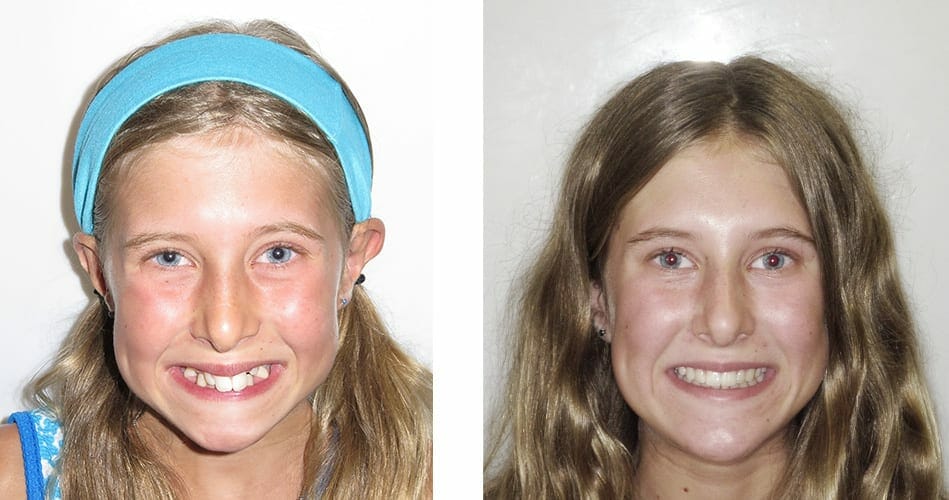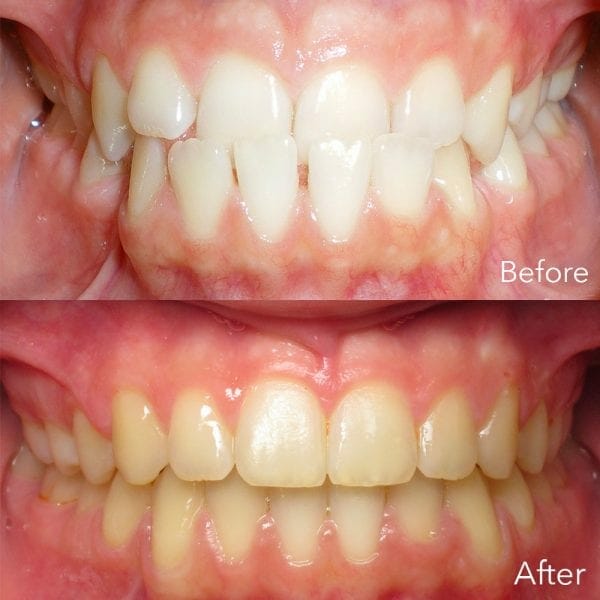What Is an Asymmetrical Face?
Symmetry is generally defined as “balanced proportions.” When it comes to human faces, symmetry means that the two sides of a face are in balance. In other words, the right side of the face looks like the left side of the face, or the top half of the face is in proportion to the lower half of the face.
However, most people do not have perfectly symmetrical faces. Most people have slight differences, such as one eye being bigger than the other, ears of different sizes, or eyelids that do not match. Although facial asymmetry is common and usually not too noticeable, it can sometimes have a dramatic effect on a person’s appearance.

What Causes an Asymmetrical Face?
There are many causes of facial asymmetry, including:
- Genetics
- Sun damage
- Smoking
- Aging
- Injury
- Bell’s palsy
- Stroke
- Lifestyle habits
- Dental issues
Although orthodontic treatment cannot address all these causes, some of the facial asymmetry caused by the misalignment of teeth and jaws (bite problems) can be corrected with orthodontic treatment.
What Types of Orthodontic Treatment Can Help Facial Asymmetry?
The two most common orthodontic treatments used to treat dental asymmetry are braces and Invisalign. However, young children with developing issues (such as a severe overbite or underbite) can benefit from the use of orthodontic appliances, including palatal expanders, Herbst appliances, and headgears. These devices are used to widen the jaw and bring the jaws, face, and teeth into proper alignment.

Why Does Early Intervention Matter for Correcting Facial Asymmetry?
In the orthodontic world, early intervention is called interceptive or phase 1 orthodontics. Interceptive orthodontics is performed on children between the ages of 7 and 11, which is when the jaw and teeth are still developing and can be more easily brought into alignment. Therefore, the American Association of Orthodontists (AAO) recommends that all children see an orthodontist by the age of 7.
With interceptive orthodontics, Dr. Burke and Dr. Redford can help guide jaw growth with a variety of orthodontic appliances, such as palatal expanders, Herbst appliances, or headgears. Each of these devices is used to correct different bite problems. However, the key takeaway is that results are possible in younger children that are not possible in older teens or adults. Interceptive orthodontics also helps to prevent more expensive and invasive treatments later in life.
Facial Asymmetry and Overbites
An overbite happens when the lower jaw or teeth set behind the upper jaw or teeth. To be classified as an overbite, the overlap must be more than 3 millimeters. Overbites are quite common. The American Dental Association estimates that almost 70% of children have some type of overbite.
An overbite can cause the upper lip to stick out and the lower lip to become stuck behind the upper front teeth. Severe overbites may also cause a patient to have the appearance of a “weak chin.” Treating an overbite can help make the face look more balanced. Orthodontic devices that may be used to correct an overbite include braces, Herbst appliances, and Carriere Distalizers. These devices bring the jaw and teeth into alignment.

Facial Asymmetry and Underbites
An underbite occurs when the lower jaw sets ahead of the upper jaw or when the bottom teeth are in front of the upper teeth when biting down. This results in a protruding chin and a face that can look significantly out of proportion. Some underbites present with an appearance of weak or underdeveloped cheek bones. Correcting an underbite can have a dramatic effect on facial symmetry.
The imbalance caused by an underbite is best treated when a patient is young. Early evaluation and interceptive treatment between ages 7 and 9 is critical. At young ages, palatal expanders and other devices may be used to widen and align the jaw. After treatment, the lower half of the face will be more balanced. The patient’s chin will also look less sharp, and overall facial features will look more proportional.

Facial Asymmetry and Open Bites
An open bite is when the upper and lower teeth do not touch or overlap in the vertical plane of space when biting down. The most common type of open bite is an anterior open bite, in which a vertical space exists between the biting edges of the upper and lower front teeth. Aside from making it more difficult to bite, chew, or speak, open bites can also make the mouth look stretched or prevent the lips from closing completely. Patients with severe open bites may have faces that look longer than they are.
Braces and Invisalign can be used to treat some open bites—helping patients to close their lips over their mouth and providing a more natural look. The patient’s face will also not look as long.

Facial Asymmetry and Crossbites
Crossbites happen when the top and bottom teeth do not come together properly. Crossbites are classified as either anterior (lower front teeth ahead of upper front teeth) or posterior (upper back teeth insider lower back teeth). With moderate or severe crossbites, patients may shift their jaw to one side, which may create a lopsided look.
Crossbites are best corrected at earlier ages and in younger children. Palatal expanders or a pendulum appliance can be used to widen the upper jaw into the appropriate proportion with the lower jaw. In some milder cases, crossbites may be treated with braces or Invisalign—resulting in a more balanced and symmetrical facial appearance. Learn more about the dental midline.
Conclusion
In this article, we’ve discussed some of the ways that teeth and jaw alignment issues can affect the symmetry of the face. However, it is important to realize that bite problems (malocclusions) cause more problems than facial asymmetry, including:
- Uneven wear on teeth
- Chewing and speaking difficulties
- Jaw discomfort
By correcting bite issues, orthodontic treatment can not only improve a patient’s appearance but prevent or correct serious dental problems. As mentioned previously, early intervention will allow Dr. Burke and Dr. Redford to achieve results in younger children that may not be possible in older teens and adults. This will help to prevent more invasive and expensive orthodontic treatment later in life.
Call (951) 699-8011 to schedule a free orthodontic consultation with Dr. Ryan Redford or Dr. Burke at our Temecula or Lake Elsinore offices or use you may use our online consultation form anytime.